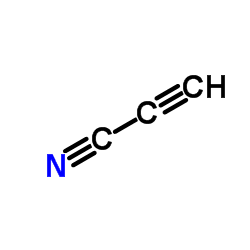543-21-5
| Name | cellocidin |
|---|---|
| Synonyms |
Cellocidin
2-butynediamide Lenamycin Acetylene dicarboxamide acetylene dicarboxylic diamide but-2-ynediamide Renamycin acetylene dicarboxylic acid diamide acetylenedicarboxamide EINECS 200-816-9 Aquamycin Acetylenedicarbonitrile |
| Density | 1.41g/cm3 |
|---|---|
| Boiling Point | 294ºC at 760 mmHg |
| Melting Point | 179ºC |
| Molecular Formula | C4H4N2O2 |
| Molecular Weight | 112.08700 |
| Flash Point | 131.6ºC |
| Exact Mass | 112.02700 |
| PSA | 86.18000 |
| Appearance | Fine Crystalline Powder | Cream to beige |
| Vapour Pressure | 0.00167mmHg at 25°C |
| Index of Refraction | 1.56 |
Synonym:2-Butynediamide; Cellocidin Section 2 - COMPOSITION, INFORMATION ON INGREDIENTS
Risk Phrases: 21 25 Section 3 - HAZARDS IDENTIFICATION EMERGENCY OVERVIEW
Harmful in contact with skin. Toxic if swallowed.Toxic. Potential Health Effects Eye: Causes eye irritation. Skin: Causes skin irritation. Harmful if absorbed through the skin. Ingestion: May be fatal if swallowed. Harmful if swallowed. Causes gastrointestinal irritation with nausea, vomiting and diarrhea. Inhalation: Causes respiratory tract irritation. Chronic: No information found. Section 4 - FIRST AID MEASURES Eyes: Immediately flush eyes with plenty of water for at least 15 minutes, occasionally lifting the upper and lower eyelids. Get medical aid immediately. Skin: Get medical aid immediately. Immediately flush skin with plenty of water for at least 15 minutes while removing contaminated clothing and shoes. Ingestion: Do not induce vomiting. If victim is conscious and alert, give 2-4 cupfuls of milk or water. Never give anything by mouth to an unconscious person. Get medical aid immediately. SPEED IS ESSENTIAL. A DOCTOR MUST BE NOTIFIED AT ONCE. Inhalation: Get medical aid immediately. Remove from exposure and move to fresh air immediately. If not breathing, give artificial respiration. If breathing is difficult, give oxygen. Notes to Physician: Section 5 - FIRE FIGHTING MEASURES General Information: As in any fire, wear a self-contained breathing apparatus in pressure-demand, MSHA/NIOSH (approved or equivalent), and full protective gear. During a fire, irritating and highly toxic gases may be generated by thermal decomposition or combustion. Extinguishing Media: In case of fire, use water, dry chemical, chemical foam, or alcohol-resistant foam. Section 6 - ACCIDENTAL RELEASE MEASURES General Information: Use proper personal protective equipment as indicated in Section 8. Spills/Leaks: Clean up spills immediately, observing precautions in the Protective Equipment section. Sweep up, then place into a suitable container for disposal. Section 7 - HANDLING and STORAGE Handling: Wash thoroughly after handling. Wash hands before eating. Remove contaminated clothing and wash before reuse. Use only in a well-ventilated area. Do not get on skin or in eyes. Do not ingest or inhale. Storage: Store in a cool, dry place. Keep container closed when not in use. Section 8 - EXPOSURE CONTROLS, PERSONAL PROTECTION Engineering Controls: Use process enclosure, local exhaust ventilation, or other engineering controls to control airborne levels. Exposure Limits CAS# 543-21-5: Personal Protective Equipment Eyes: Wear appropriate protective eyeglasses or chemical safety goggles as described by OSHA's eye and face protection regulations in 29 CFR 1910.133 or European Standard EN166. Skin: Wear appropriate protective gloves and clothing to prevent skin exposure. Clothing: Wear appropriate protective clothing to prevent skin exposure. Respirators: Follow the OSHA respirator regulations found in 29 CFR 1910.134 or European Standard EN 149. Use a NIOSH/MSHA or European Standard EN 149 approved respirator if exposure limits are exceeded or if irritation or other symptoms are experienced. Section 9 - PHYSICAL AND CHEMICAL PROPERTIES Physical State: Solid Color: Not available. Odor: none reported pH: Not available. Vapor Pressure: Not available. Viscosity: Not available. Boiling Point: Not available. Freezing/Melting Point: 179 deg C Autoignition Temperature: Not available. Flash Point: 216 deg C ( 420.80 deg F) Explosion Limits, lower: Not available. Explosion Limits, upper: Not available. Decomposition Temperature: 216 deg C Solubility in water: slightly soluble Specific Gravity/Density: Molecular Formula: C4H4N2O2 Molecular Weight: 112.09 Section 10 - STABILITY AND REACTIVITY Chemical Stability: Stable under normal temperatures and pressures. Conditions to Avoid: Incompatible materials. Incompatibilities with Other Materials: Strong oxidizing agents. Hazardous Decomposition Products: Irritating and toxic fumes and gases. Hazardous Polymerization: Has not been reported. Section 11 - TOXICOLOGICAL INFORMATION RTECS#: CAS# 543-21-5: AO9900000 LD50/LC50: CAS# 543-21-5: Oral, mouse: LD50 = 89200 ug/kg. Carcinogenicity: Acetylenedicarboxamide, pract. - Not listed by ACGIH, IARC, or NTP. Other: See actual entry in RTECS for complete information. Section 12 - ECOLOGICAL INFORMATION Section 13 - DISPOSAL CONSIDERATIONS Dispose of in a manner consistent with federal, state, and local regulations. Section 14 - TRANSPORT INFORMATION IATA Not regulated as a hazardous material. IMO Not regulated as a hazardous material. RID/ADR Not regulated as a hazardous material. Section 15 - REGULATORY INFORMATION European/International Regulations European Labeling in Accordance with EC Directives Hazard Symbols: T Risk Phrases: R 21 Harmful in contact with skin. R 25 Toxic if swallowed. Safety Phrases: S 28A After contact with skin, wash immediately with plenty of water. S 36/37 Wear suitable protective clothing and gloves. S 45 In case of accident or if you feel unwell, seek medical advice immediately (show the label where possible). WGK (Water Danger/Protection) CAS# 543-21-5: No information available. Canada CAS# 543-21-5 is listed on Canada's NDSL List. CAS# 543-21-5 is not listed on Canada's Ingredient Disclosure List. US FEDERAL TSCA CAS# 543-21-5 is listed on the TSCA inventory. SECTION 16 - ADDITIONAL INFORMATION N/A |
CHEMICAL IDENTIFICATION
HEALTH HAZARD DATAACUTE TOXICITY DATA
|
| Hazard Codes | T |
|---|---|
| Risk Phrases | 25-21 |
| Safety Phrases | 45-36/37-28A |
| HS Code | 2924199090 |
|
~94% 
543-21-5 |
| Literature: Winther, F.; Ketelsen, M.; Guarnieri, A. Journal of Molecular Structure, 1994 , vol. 320, p. 65 - 74 |
|
~% 
543-21-5 |
| Literature: Journal of Organic Chemistry, , vol. 10, p. 392 |
| HS Code | 2924199090 |
|---|---|
| Summary | 2924199090. other acyclic amides (including acyclic carbamates) and their derivatives; salts thereof. VAT:17.0%. Tax rebate rate:13.0%. . MFN tariff:6.5%. General tariff:30.0% |



